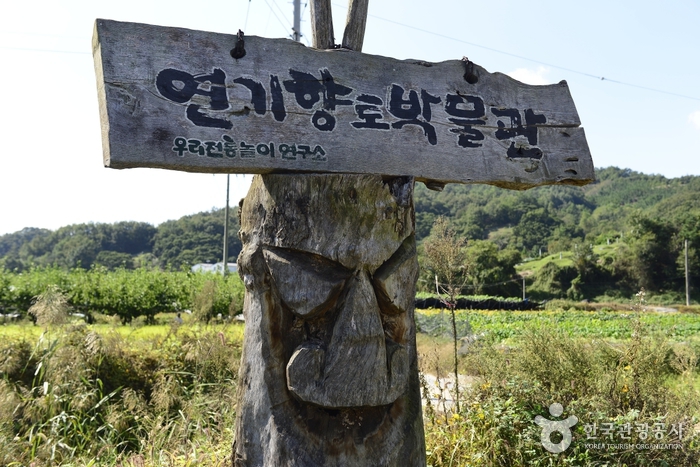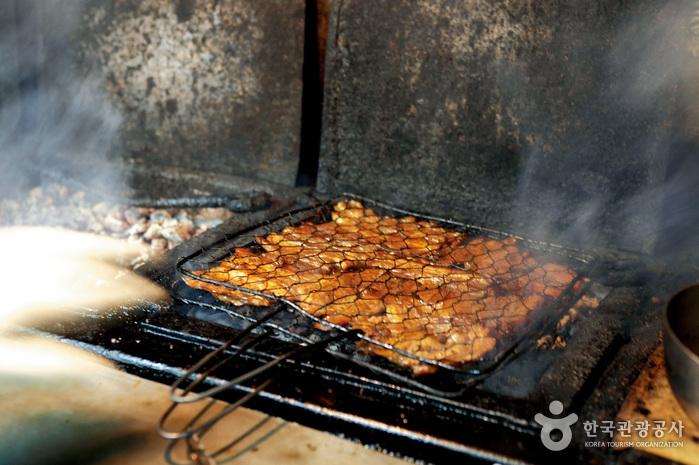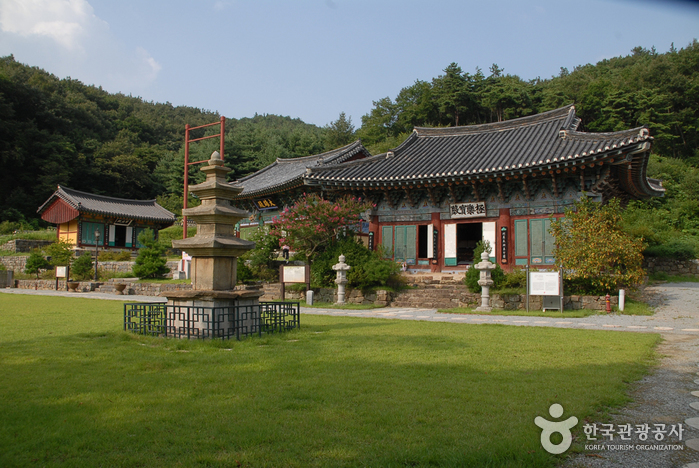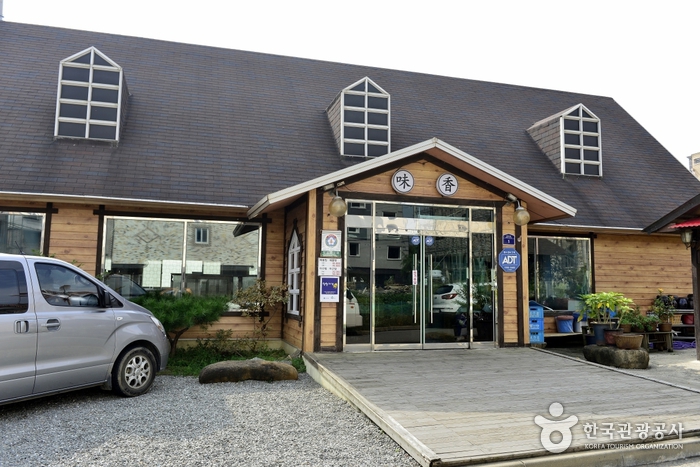Gobok Natural Park (고복자연공원)
0m 21809 2021-12-07
586, Dosingobok-ro, Sejong-si
+82-44-300-4216
Gobok Natural Park spans an area of 1,840,000 square meters and nearby attractions include a forest, Yonggul Cave, Sinheungsa Temple, and an outdoor sculpture park on Obongsan Mountain. A 3.65-kilometer-long deck circles the reservoir. The neighboring village is home to orchards for growing grapes, peaches, and pears. The park has a large meeting square and the outdoor sculpture park features works by Ewha Woman's University art professor Kang Tae-seong, attracting many visitors. The park is especially popular in summer when the outdoor swimming pool is open. In spring, people flock to Millakjeong Pavilion to view the cherry blossoms. There are many restaurants nearby specializing in galbi (ribs), Hanbang ori (duck with medicinal herbs), and megi maeuntang (spicy catfish stew), as well as cafes overlooking the natural scenery.
Wondumak (원두막)
1.3 Km 8715 2016-09-06
154, Ansan-gil, Yeonseo-myeon, , Sejong-si
+82-41-867-5727
Wondumak is a Korean restaurant specializing in hot soups. Popular menu items include minmul saeutang (spicy fresh water shrimp soup), megi maeuntang (spicy catfish soup), and tojong dakdoritang (chicken hot pot). The restaurant also offers fantastic views of the Gobok Reservoir.
Yeongi Folk Museum (연기향토박물관)
1.8 Km 11867 2019-03-18
34-4, Yangdae-gil, Yeonseo-myeon, , Sejong-si
+82-44-862-7449
Opened in August 1966, the Yeongi Folk Museum showcases relics found in the old site of Sejong Special Self-Governing City. Over 1,000 relics, including Buddhist statues, weapons, pagodas, earthenware, porcelain, bronze ware, roof tiles, paintings, letters, houseware, kitchenware, farming tools, and others are arranged by era.
Sanjang Garden (산장가든)
3.1 Km 15007 2024-03-20
1131-7 Dosingobok-ro, Yeonseo-myeon, Sejong-si
+82-44-867-3333
Sanjang Garden is a Korean restaurant specializing in grilling pork galbi over charcoal. In addition to pork galbi, they also serve dishes such as naengmyeon (cold buckwheat noodles), dongchimi guksu (noodles with radish water kimchi), and sujebi (hand-pulled dough soup). Surrounded by lakes and mountains, the restaurant offers a picturesque setting and has been featured multiple times on Korean television. It's approximately a 15-minute drive from Jochiwon Station by car or taxi.
Biamsa Temple - Sejong (비암사(세종))
3.4 Km 15365 2020-04-02
137, Biamsa-gil, Sejong-si
+82-44-863-0230
The origin of Biamsa Temple is unknown, but the temple's architectural features suggest that it was built during the mid Goryeo dynasty period (918-1392). The Geungnakbojeon Hall and the three-storied pagoda inside the temple have been designated as Cultural Properties of Chungcheongnam-do Province. The flamboyang and delicately crafted datjip (canopy) inside the Geungnakbojeon Hall was restored in 1657 during the 8th year of King Hyojong's reign.
In the yard in front of the Geungnakbojeon Hall stands the three meter-high Samcheungseoktap (three-storied stone pagoda). With the discovery of Samyeongunsang stone statues near the top of the pagoda, Biamsa Temple became more widely known to the public. Among the stone statues, Gyeyumyeongjeonssi-amitabul-samjonseoksang (three Buddha statues) has been named as National Treasure No. 106, and Gichukmyeong-amitayeorae-jebulbosalseoksang (statue of Amitabha bodhisattva) and Mireukbosal-bangaseoksang (statue of Maitreya bodhisattva) have been designated as National Treasures No. 367 and No. 368, respectively. The stone statues are preserved in National Museum of Korea. Meanwhile, the three-storied stone pagoda was designated as Tangible Cultural Property No. 119 of Chungcheongnam-do Province on July 19, 1985.
Geumisanseong Fortress (금이성)
4.2 Km 12330 2020-03-17
Songseong-ri, Sejong-si
+82-44-300-3444
Geumiseong is a mountain fortress built on the summit of Geumseongsan Mountain, which rises 430 meters above sea level. It overlooks Jeonui and Cheonan to the north and Geumgang River to the south. The architecture style of Geumiseong Fortress is a combination of the
styles of the Baekje dynasty and the early Unified Silla. Based on the relics found inside the fortress, it is thought to have been built in the Goryeo period. The robustness of the fortress takes advantage of the rugged topography, so much so that it had been known as ironclad bastion among common people.
The eastern side of the fortress has considerably collapsed, but the southern part is in a relatively good condition. The western and northern walls are also in bad conditions.
Some earthenware pieces were found where there once stood a watchtower. Also, some pieces of roof tiles were found where there was a fortress building in the central part of the fortress on mountain summit. The earthenware pieces are hard porcelain and soft glass wares like bowls and pots. The tile pieces mostly feature fishbone patterns in dark gray color.
Sejong Yeonhwasa Temple (연화사 (세종))
4.7 Km 12073 2022-10-13
28-1, Yeonhwasa-gil, Sejong-si
+82-44-862-8620
Yeonhwasa Temple is said to have been built by Hong Mun-seop. After having a dream, Hong dug the current site of Yeonhwasa Temple to find two stone Buddha statues and built a temple there. It was designated a traditional temple in 1988. The temple features Muryangsujeon Hall, Samseonggak Hall, and Yosachae (monks’ residence).
There used to be a building with a tile roof, but following the discovery of a stele with the inscription of “Muin Year” and a pedestal, the roof was improved. The side of the stele is in a trapezoid shape with a wider bottom. It is thought to date back to the Unified Silla era. The temple is also home to a stele with seven relief Buddhist images. Together with the stone images of Biamsa and Jeonganmyeon, this stele is considered to have cast a new light on the Ancient Art.
La Foresta (라포레스타)
4.8 Km 0 2024-02-20
130 Daecheop-ro, Yeonseo-myeon, Sejong-si
La Foresta is a café with a spacious outdoor garden. The interior has a cozy atmosphere with wood tones. The garden is adorned with various types of trees and flowers, creating a park-like ambiance. Signature drinks include foresta double latte, made with hazelnut milk and espresso, blood orange featuring blood orange infused tea, and dewy cherry mango, a refreshing blend of cherry tea with mango puree and coconut jelly.
Sejong Culture & Arts Center (세종문화예술회관)
5.3 Km 7444 2021-09-01
22, Munyehoegwan-gil, Sejong-si
+82-44-301-3523
Located in Sejong Special Self-Governing City, the Sejong Culture & Arts Center is a multi-purpose cultural space for performances and exhibitions. It offers a variety of opportunities for local artists as well as a place to enjoy culture and arts for local residents.
Mihyang (미향)
5.5 Km 10778 2016-10-25
1, Munhwa 4-gil, Jochiwon-eup, Sejong-si
+82-41-866-3173
Mihyang is a seafood restaurant specializing in haemul-jjim (steamed seafood).





 English
English
 한국어
한국어 日本語
日本語 中文(简体)
中文(简体) Deutsch
Deutsch Français
Français Español
Español Русский
Русский